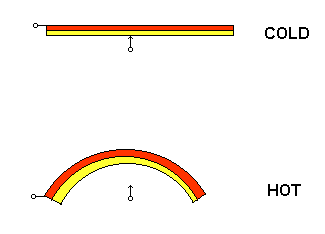|
When an object is heated above the temperature of its surroundings it will lose heat to the surroundings. Heat is transferred in three ways.
1. CONDUCTION
- If one end of a metal bar is heated then heat is transferred by conduction to the cold end.
- Good electrical conductors such as copper and gold are good conductors of heat.
- Poor electrical conductors, such as wood and paper, are poor heat conductors.
- Heat can be conducted between two objects if they are in close contact.
- For example between a soldering iron and a soldering terminal; or between a power transistor and its
heat sink.
2. CONVECTION
- Here, heat is transferred by the movement of a gas or a liquid.
- Hot air rises and cold air falls. Liquids behave in a similar manner.
- A hot resistor causes convection, transferring heat from the resistor to the surrounding air.
- Hot water in a pan rises to the top while the cold water falls to the bottom.
- These movements are called convection currents (nothing to do with electric currents).
- The above process is called NATURAL CONVECTION.
- If a fan is used to aid convection it is called FORCED CONVECTION.
3. RADIATION - This does not need a gas or liquid to transfer the heat.
- Heat is expelled mostly in the form of infrared radiation.
- This is a form of light and travels at the speed of light.
- It can travel through a vacuum.
- This is why we can feel the heat of the sun even though it has to travel
through the vacuum of space to reach earth.
- Polished surfaces are poor radiators but good reflectors of heat. That is why electric fires have shiny reflectors.
- Black objects are good radiators.
4. THE EFFECTS OF HEAT - Heat causes solid objects to expand.
- That is why they have gaps in railway lines and bridges to allow for summertime temperatures.
- Different metals expand at different rates.
- A temperature switch can be made from two strips of dissimilar metals fixed together.
- As the temperature increases, one strip grows longer than the other, causing the strips to curve. This in turn breaks (or makes) a circuit.

- Increasing temperatures also cause liquids to expand. This behaviour is used in the thermometer.
- Gases also expand with temperature increases.
5. HEAT AND ELECTRONICS
- Heat is one of the biggest enemies of electronics, causing components to fail.
- To minimize the effects some action can be taken.
- Increasing the surface area increase convection and radiation. High
wattages resistors are larger than low wattage ones.
- Using holes and louvers in the casing increases natural convection.
- Using fans provides forced convection.
- Using heat sinks with fins increases surface area thus providing increased convection and radiation.
- Painting heat sinks blacks increases radiation.
- Using "heat sink compound", which is a good conductor, between transistors and their heatsinks, improves heat conduction.
- Fitting components onto the metal chassis aids the dissipation of heat.
|